Key takeaways:
- The number of pages a website needs depends on your business goals and type.
- A business website’s core pages should help establish its brand, offer essential information, and help build trust with visitors.
- When building a website, focus on user experience and performance to increase engagement and conversions.
When building a website, one of the first questions to consider is what pages it should have. The number and type of pages depend on your business’s goals, audience needs, and desired user experience. Choosing the right pages is important so you can provide your visitors with the information they need and seamlessly guide them through your website.
In this article, we’ll break down the key pages every business website needs, factors influencing how many pages you should have, and why these pages matter.
How many pages should a business site have?
The number of pages your business site requires depends on your business type and goals. There is no specific number, and there are some cases where a one-pager website will do. Nevertheless, a minimum of 5 to 10 pages for most websites is a good starting point.
Small businesses going for a simple online presence should aim for around 5 to 15 pages. This number provides enough content to improve your search engine visibility while maintaining a smooth and intuitive user experience. While there’s no one-size-fits-all answer, a multi-page website is often a wise choice for most businesses looking to establish a strong online presence.

What pages should a business website have?
Your website often gives potential customers the first impression of your business. It’s important that it reflects your brand, offers clear information, and encourages action. The pages you include significantly shape how visitors perceive your business and how easily they can navigate your offerings.
Here are the key pages your website should have:
- Home page
- About us page
- Service/Product page
- Contact us page
- Privacy policy page
- Terms of service page
Let’s take a closer look at each page:
Home page
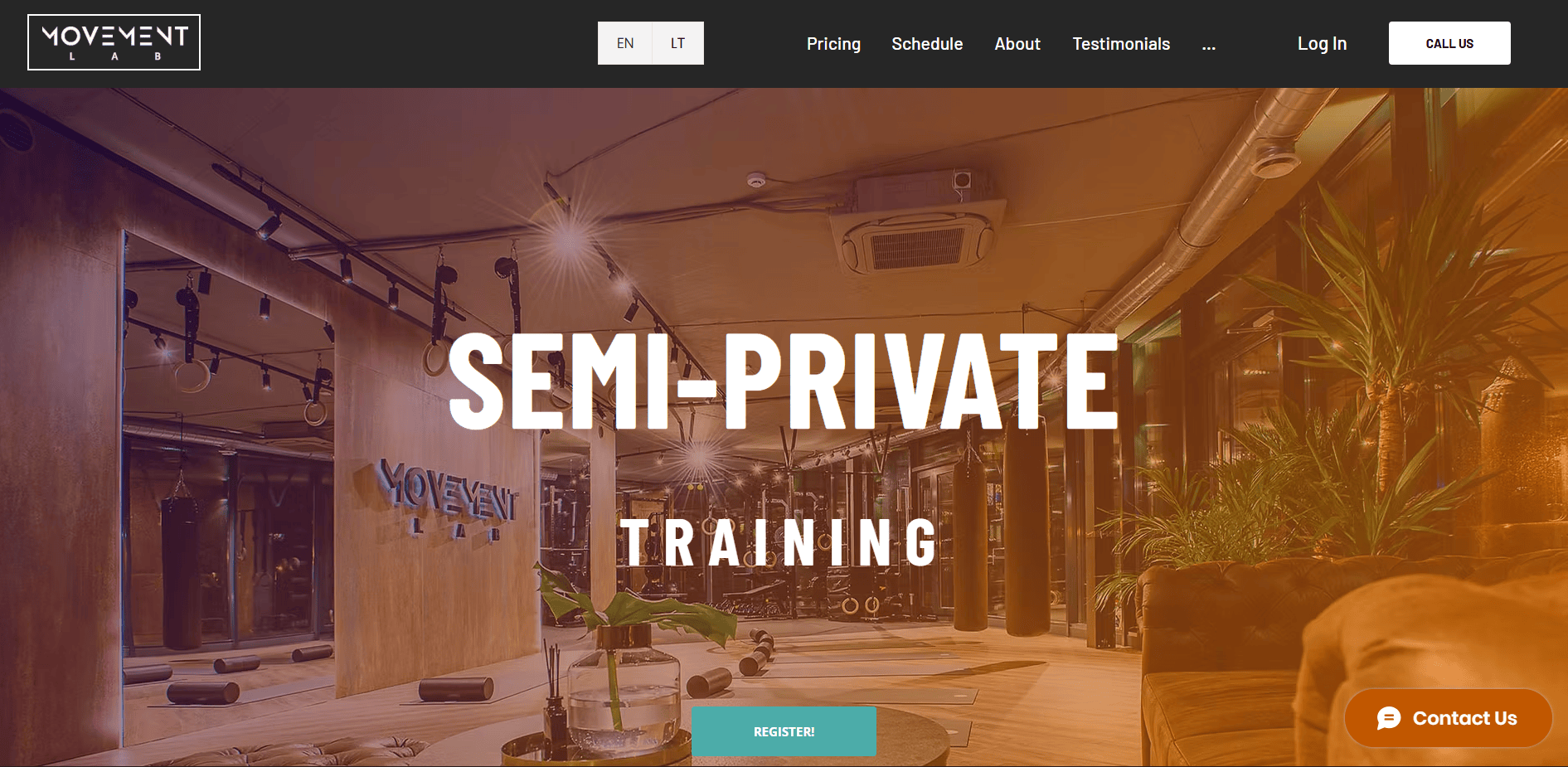
(Image source: https://www.movementlab.lt/)
Your home page is your website’s face and serves as the central hub, guiding visitors to the right sections of the site. Make it effective in catching visitors’ attention by adding:
- Clear branding (e.g., logo, tagline, or business mission)
- Easy-to-navigate menu or call-to-action (CTA) buttons
- Featured sections highlighting services, products, or key offerings
- A clean and visually appealing design with key website information
About us

(Image source: https://littlekarmaco.com/pages/about-us)
The about us page tells your company’s story, mission, and values. It helps customers connect with your brand and learn about the people behind the business. This page is important because visitors want to know who they’re dealing with before they purchase or inquire.
The following are some of the important elements you should consider adding to your ‘About us’ page:
- Brief history of your company
- Company’s mission, vision, and values
- Key team members
- Notable achievements or certifications that show expertise
Services/Products
This page outlines what you offer, whether services, products, or both. It’s where visitors can learn about your offerings in detail. Potential customers need clear information about what you’re selling, how it works, and why it’s valuable. Without this page, visitors may leave because they can’t find what they need.
When creating product pages, make sure to add:
- Clear descriptions of each service/product
- Pricing (if applicable)
- High-quality images or videos to showcase the product/service
- Calls to action to encourage inquiries or purchases
- Special offers, promotions, or packages
Contact us
This page provides multiple ways for visitors to contact your business. These can include:
- Contact form
- Phone number
- Email address
- Physical address (if applicable)
- Social media links
- A map for physical locations
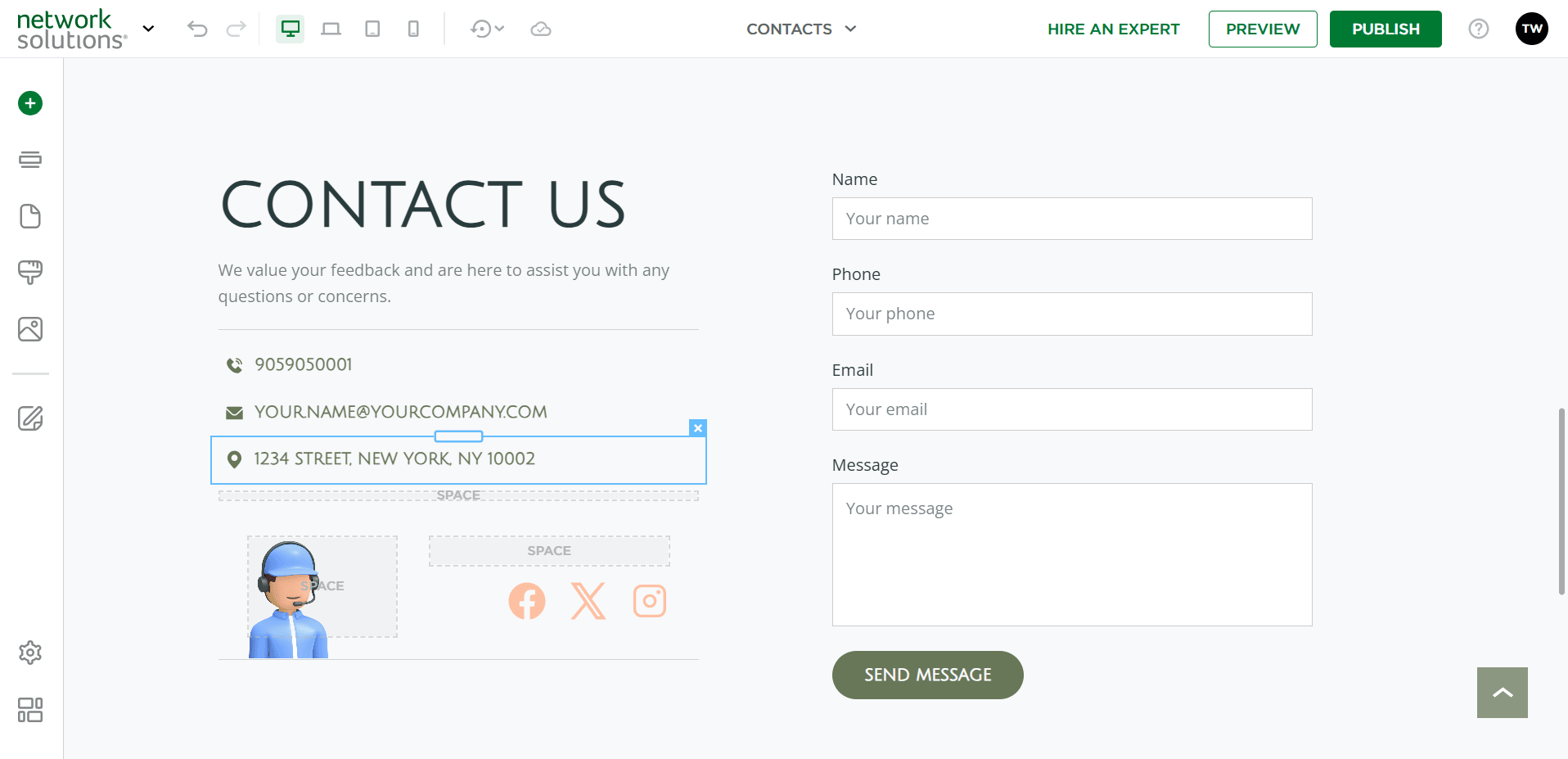
Make it easy for customers to get in touch. This page ensures that they can easily do so. Most website services, such as Network Solutions’ Website Builder, provide features that enable you to easily add a contact page in just a few clicks.
Privacy policy
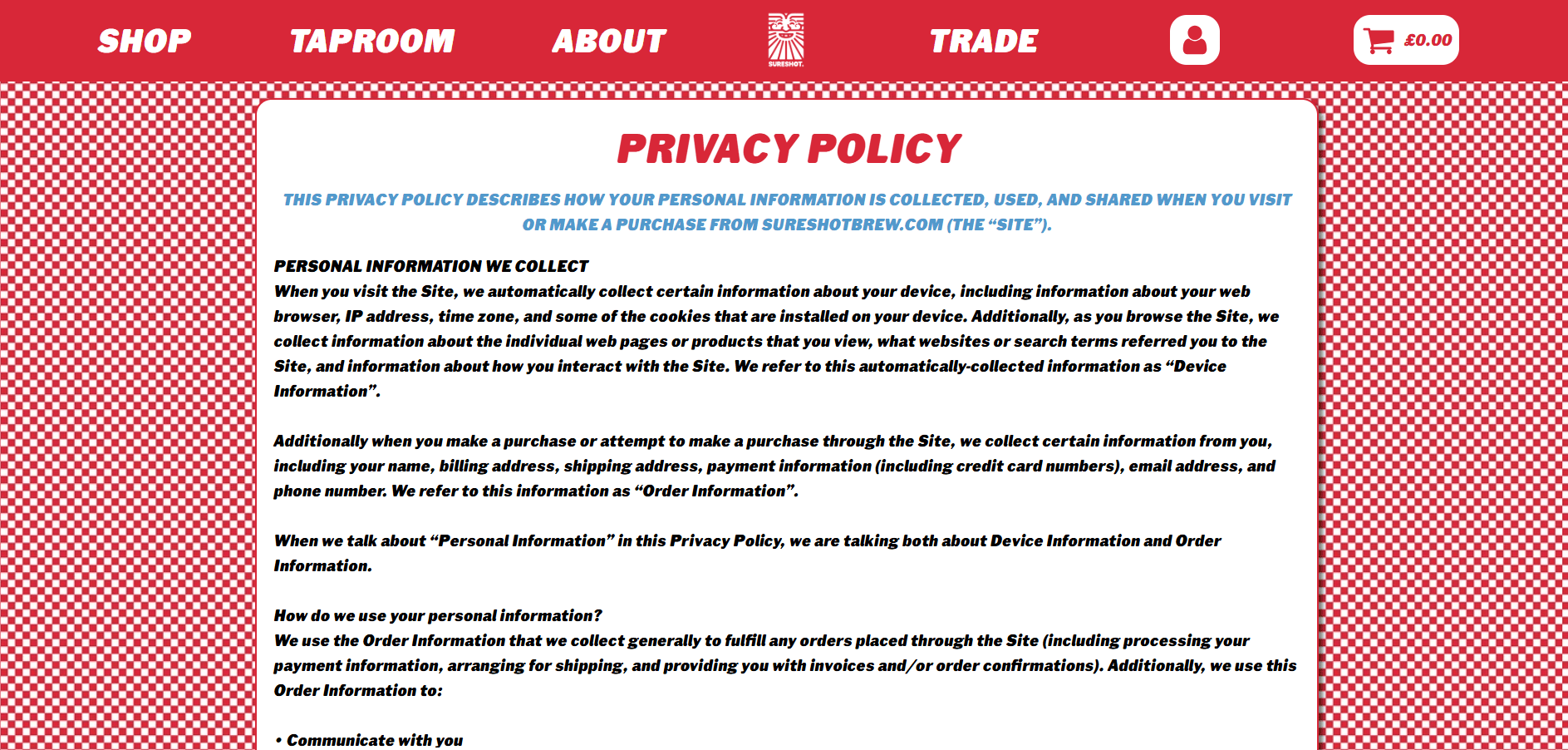
(Image source: https://sureshotbrew.com/privacy/)
The privacy policy page explains how your business collects, uses, and protects customer data. This page is a legal necessity, especially if you handle sensitive information such as personal data, credit card details, or email addresses. It assures visitors that you handle their personal information responsibly.
Below is some information you need to include on your Privacy policy page.
- What data is collected
- How you use customer data
- Data protection measures
- How users can manage their data
Terms of service
The Terms of Service (TOS) page is a legal agreement between your business and website users. It outlines the rules, responsibilities, and guidelines for using your website or services. This page is important for protecting your business and setting clear user expectations. For most businesses that provide services and sell products (especially eCommerce), having a TOS page is strongly recommended.
Make sure to include the following components when creating your TOS page:
- Terms regarding the use of your website or services
- Payment terms (if applicable)
- Refund and cancellation policies for services or products
- Dispute resolution procedures
- Limitation of liability and other legal disclaimers

Additional pages to enhance user experience
While there are essential pages every business website needs, adding extra pages can enhance user experience and offer more value to visitors.
Here are some additional pages you might consider including in your website:
- Blog
- FAQ
- Testimonials
- Knowledge base
- Portfolio
Blog
A blog page provides helpful, relevant content to your audience. It includes articles, guides, case studies, or industry news. Publishing this type of content is good for engine optimization (SEO), build your authority, and give visitors more reasons to return.
FAQ
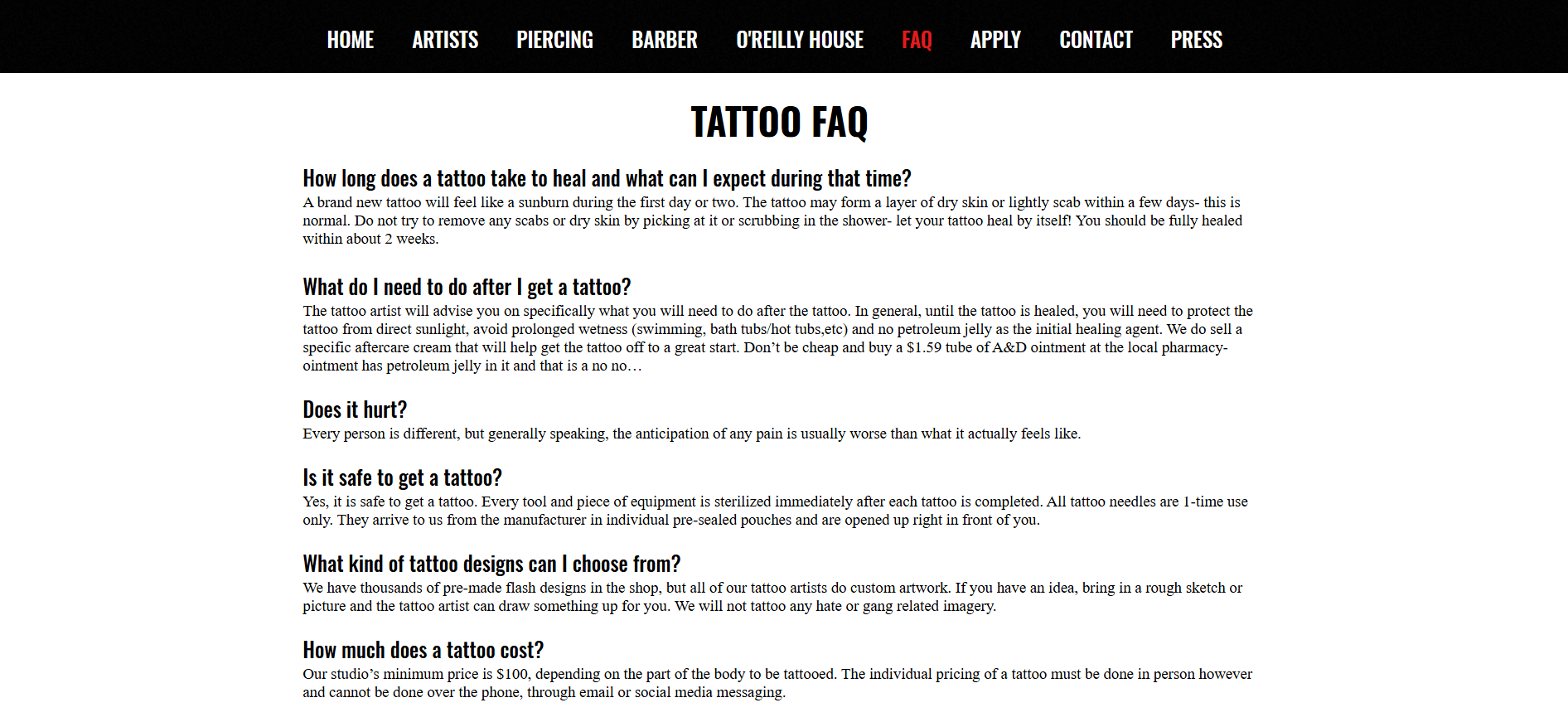
(Image source: https://www.bostontattoo.com/faq)
An Frequently Asked Questions (FAQ) page addresses common customer inquiries. This page helps reduce the need for direct customer support and help users find answers quickly.
Testimonials
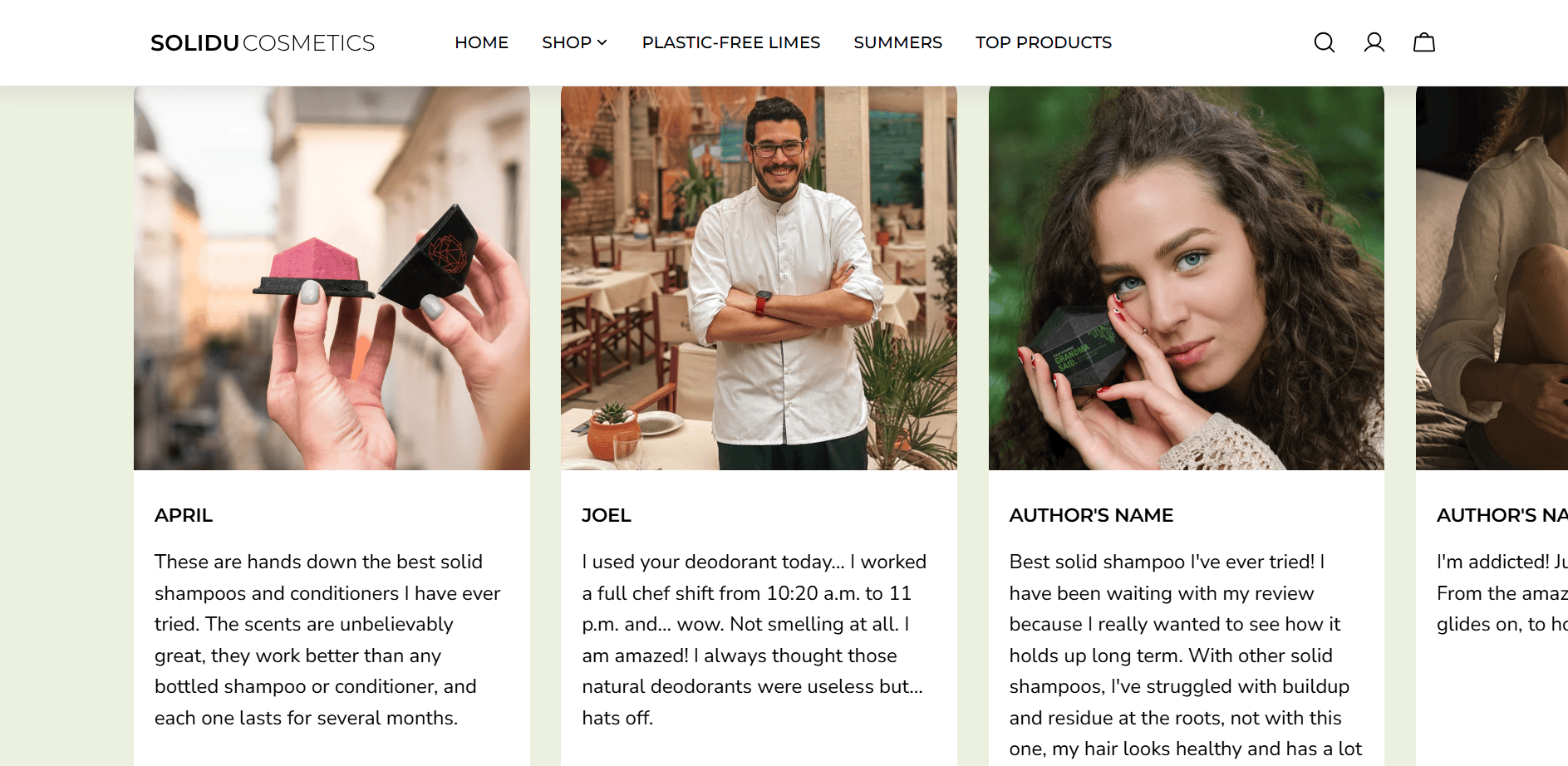
(Image source: https://soliducosmetics.com/)
A page dedicated to customer reviews and testimonials highlights successful experiences with your business. Social proof plays a massive role in trust-building. Visitors are more likely to engage with your business if they see that others have done so and had positive experiences with your brand.
Knowledge base
A knowledge base page is a repository of guides, white papers, or tutorials that help users understand your products, services, or industry. It also positions your business as an expert, offers valuable self-service, and can support SEO.
Portfolio
For businesses that offer design, consulting, or creative services, a portfolio page showcases past projects, work samples, or success stories. A well-curated portfolio demonstrates your capabilities, giving potential clients a solid idea of the quality of your work.
Factors influencing how many pages on a website
Several factors can influence the number of website pages. Understanding these can help you create a site that’s optimized for users and search engines:
- Business type and industry
- Content strategy
- SEO goals
- User experience
Business type and industry
The nature of your business is important in determining the number of web pages. For instance, eCommerce sites require many pages to showcase all products and categories. On the other hand, service-based businesses might only need a few core pages that highlight their services.
Content strategy
If you plan to post blogs or articles on your site regularly, you’ll need more pages. Blog posts can help you target a variety of topics and offer more entry points for visitors.
SEO goals
In SEO, having more pages that target specific long tail keywords can boost your ability to rank for various search queries. However, make sure that you’re creating quality content rather than just sheer numbers that don’t provide value to your audience.
No time to do this yourself? Our experts are ready to help you win in SEO.
User experience
Your website’s design and content organization also influence the number of pages you need. Splitting content into multiple pages is ideal rather than overwhelming users with a single long page for a better user experience.
Recommended pages by industry
Different industries benefit from different website structures to meet the needs of their audience. Below is a breakdown of recommended pages for different industries:
| Industry | Suggested pages | Key inclusions |
| Local service | 8–12 | Home, About, Services, Reviews, Blog, Contact |
| eCommerce | 15–30+ | Home, Product Categories, Product Pages, Policies, Terms, FAQ, Blog |
| Coaching | 10–15 | Home, About, Services, How It Works, Testimonials, Contact |
| Restaurants | 5–10 | Home, Menu, Location, Reviews, Contact |
| Nonprofits | 10–20 | Home, Mission, Programs, Donate, Team, Events, Contact |
| Real estate | 12–25 | Home, Property Listings, About, Testimonials, Contact |
| Health and wellness | 8–15 | Home, About, Services, Blog, Contact, FAQ |
| Education | 10–20 | Home, Course Offerings, About, Blog, Testimonials, FAQ, Contact |
| Design/Graphic design | 8–15 | Home, Portfolio, About, Services, Contact |
Local service
Local service websites typically require 8–12 pages to present the necessary information. These key pages help website visitors quickly understand the services offered, the company’s mission, and customer feedback. A blog can also enhance local SEO and engagement. At the same time, a contact page ensures users can easily reach out for more information. and engagement. At the same time, a contact page ensures users can easily reach out for more information.
eCommerce
ECommerce sites require detailed product pages that explain offerings clearly and outline policies, especially around payments and returns. FAQs and blog pages also help improve user experience and site engagement.
Coaching
Coaches need a website that establishes their authority and clearly explains their services. Simplified navigation ensures potential clients can easily find relevant details. The 10–15 page range balances showcasing services and maintaining a clean, focused design.
Restaurants
Restaurant websites should showcase the menu and location details. Reviews help boost customer engagement, while clear contact information supports seamless bookings. The compact five- to ten-page range ensures the site is quick to navigate so diners can find what they need without feeling overwhelmed.
Nonprofits
Nonprofit websites should highlight their mission and cause and provide clear steps to donate or get involved. Including team details and promoting events fosters community engagement and trust.
Real estate
Real estate websites need a strong property page with filters and detailed descriptions. Contact forms and testimonials are important for generating leads and inquiries.
Health and wellness
Health and wellness websites benefit from clear, informative services, blogs, and FAQ pages. These resources help users understand the services and know what to expect from them. Trust and transparency are important in this industry.
Education
Educational institutions typically need 10–20 pages on their website to provide a well-rounded, user-friendly experience. The key pages offer prospective students the information they need about courses, the institution’s mission, success stories, and other important details like admissions or program specifics.
Design/Graphic design
Design businesses should showcase their portfolio to highlight their skills and attract clients. The 8–15 page range helps maintain a clean, professional site that showcases design skills while providing essential information to prospective clients.
Common mistakes to avoid with website pages
When building a business website, there are several pitfalls you should avoid. Mistakes like the ones we outline below can negatively impact conversions, user experience, and search rankings.
- Cluttered layout
- Slow loading times
- Lack of clear CTAs
- Non-mobile-friendly design
- Overuse of stock photos
- Inadequate contact information
- Neglecting SEO
- Poor navigation structure
Let’s explore each in detail and learn how to avoid them:
Cluttered layout
A cluttered website layout can overwhelm visitors with too much information and too many elements fighting for attention.
To create a positive experience, keep your pages clean and easy to navigate. Use ample white space, break up text with headers and bullet points, and prioritize the most important content.
Slow loading times
A slow website drains visitors’ patience and makes them leave before they even can explore your site. Users typically expect a website to load within three seconds or less. If it takes longer, you could lose their attention to a competitor.
Test your website’s speed regularly using tools like Google PageSpeed Insights or GTmetrix. Improve your website speed by:
- Compressing images without sacrificing quality.
- Minifying your website’s CSS and JavaScript files.
- Using a content delivery network (CDN) to speed up load times globally.
Lack of clear CTAs
Without clear calls to action, users may not know what steps to take next. Failing to guide them could result in lost opportunities, whether you want them to complete a purchase, join your newsletter, or book a consultation.
To avoid this, ensure every page has at least one clear and direct CTA. A prominently displayed “Shop Now,” “Get a Free Quote,” or “Learn More” can make a difference. Place them at strategic points on the page, such as after a compelling argument or piece of content, so visitors are immediately prompted to take action.
Non-mobile-friendly design
As mobile traffic rises, websites that aren’t optimized for mobile devices create a frustrating experience for many users. Mobile visitors may leave the site if it isn’t responsive, appears disorganized, or is difficult to navigate on smaller screens.
Make your website mobile-friendly. Implement responsive web design, which adjusts site content and layout depending on the device users use. Test your site on various devices and screen sizes to ensure everything looks and functions as it should.
Overuse of stock photos
While stock images are convenient, they often feel generic. They don’t reflect your brand’s identity, and visitors may see them as inauthentic.
Use original images that reflect your products, services, or team whenever possible. Custom visuals help tell your brand’s unique story and foster a deeper connection with your target audience.
Inadequate contact information
If your contact details are missing or hard to find, potential customers may give up on reaching you.
Place your contact information in prominent locations on your website, like the footer or the header. Include multiple contact methods, like email, phone number, social media, and contact forms, so users can easily get in touch.
Neglecting SEO
Without SEO, your website will struggle to appear organically in search engine results. Missing out on SEO best practices means your website is less likely to be found by potential customers, even if you have great content and services.
Optimize your website for search engines by using relevant keywords, meta descriptions, alt tags for images, and a clean URL structure. Regularly update your content with useful, keyword-rich material that provides valuable information. Additionally, ensure that your website loads fast and is optimized for mobile, as both contribute to better search engine rankings.
Poor navigation structure
Disorganized navigation makes it hard for users to find what they need.
Simplify your site’s navigation by grouping related pages and using descriptive labels. Limit the number of menu items in the nav bar to ensure visitors don’t feel overwhelmed. Your main navigation should also focus on your most important content—services, about, and contact details. Add a search bar to help visitors quickly find specific information without unnecessary clicks if possible.
Build a strong online presence with the right pages
Creating an effective business website is important for establishing your online presence. The pages you include shape how users navigate, engage with your content, and trust your brand. By carefully selecting the right pages and paying attention to user experience, you can create a website that serves your audience’s needs and drives your business forward.
If you’re ready to get started with a professional-looking website that’s easy to build and manage, Network Solutions’ AI Website Builder is the perfect solution. With its intuitive drag-and-drop interface, customizable templates, and easy-to-use features, you can create a polished site in no time.
If you need help or simply don’t have the time to do this yourself, you can always speak with our experts who are ready to help you. They make web designs and online marketing campaigns that help you stand out and elevate your online presence.
Frequently asked questions
At a minimum, every business website should include the following pages:
Home page – provides an overview and first impression
About page – shares your background, mission, and values
Services/Products page – highlights what you offer
Contact page – makes it easy for visitors to reach you
Privacy Policy page – explains how you collect, use, and protect visitor data
A business website should include content that reflects your brand’s identity, detailed descriptions of your products or services, trust-building elements like testimonials, clear calls to action, and easy navigation to help users find information quickly and efficiently.
The Home page is the most effective because it provides a first impression, communicates your value proposition, and directs visitors to other key pages. A strong home page with clear CTAs can increase user engagement and drive conversions.




